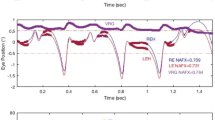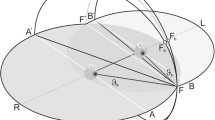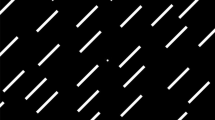Abstract
Rotation of a display in the frontal plane evokes a conjugate nystagmic rotation of the eyes (cycloversion) about the visual axes, with slow phases in the direction of stimulus motion - a response known as torsional optokinetic nystagmus (TOKN). Antiphase rotation of large dichoptic displays evokes a disconjugate rotation of the eyes about the visual axes, a response known as cyclovergence. Using the scleral-coil technique for monitoring eye movements we recorded TOKN evoked by black-and-white sectored displays rotating about the visual axis at an angular velocity of 30°/s. The display was confined to central areas with diameters ranging from 5° to full field or with the central 5° to 75° occluded. A 5° central display evoked TOKN with 40% of the gain for the full-field display and gain increased as a function of the size of the display. The gain of TOKN decreased with increasing size of a central occluder. These characteristics of TOKN are similar to those of horizontal OKN. Cyclovergence was virtually absent with a 5° display but was immune to occlusion of the central 40°. Cyclovergence therefore differs from cycloversion in showing no preference for centrally placed stimuli. These effects are free from the influence of stationary edges, since these were concentric with the stimulus motion. The effects are also free from the influence of voluntary pursuit, since humans do not normally have voluntary control over torsional eye movements.
Similar content being viewed by others
References
Brecher GA (1934) Die optokinetische Auslösung von Augenrollung und rotatorischem Nystagmus. Pflugers Arch Ges Physiol 234:13–28
Cheng M, Outerbridge JS (1974) Intersaccadic interval analysis of optokinetic nystagmus. Vision Res 14:1053–1058
Cheung BSK, Howard IP (1991) Optokinetic torsion: dynamics and relation to circularvection. Vision Res 31:1327–1336
Collewijn H, Van der Steen L, Ferman L, Jansen TC (1985) Human ocular counterroll: assessment of static and dynamic properties from electromagnetic scierai coil recordings. Exp Brain Res 59:185–196
Crone RA (1975) Optically induced eye torsion. II. Optostatic and optokinetic cycloversion. Von Graefes Arch Klin Exp Ophthalmol 196:1–7
Crone RA, Everhard-Halm Y (1975) Optically induced eye torsion. I. Fusional cyclovergence. Von Graefes Arch Klin Exp Ophthalmol 195:231–239
Die G van, Collewijn H (1986) Control of human optokinetic nystagmus by the central and peripheral retina: effects of partial visual field masking, scotopic vision and central retinal scotomata. Brain Res 383:185–194
Ferman L, Collewijn H, Jansen TC, Berg AV van den (1987a) Human gaze stability in horizontal, vertical and torsional direction during voluntary head movements, evaluated with a three-dimensional scierai induction coil technique. Vision Res 27:811–828
Ferman L, Collewijn H, Berg AV van den (1987b) A direct test of Listing’s law. I. Human ocular torsion measured in static tertiary positions. Vision Res 27:929–938
Goodenough DR, Sigman E, Oltman PK, Rosso J, Mertz H (1979) Eye torsion in response to a tilted visual stimulus. Vision Res 19:1177–1179
Helmholtz H von (1909) Treatise on physiological optics, vol 3. Dover, New York, 1962, p 408
Howard IP, Ohmi M (1984) The efficiency of the central and peripheral retina in driving human optokinetic nystagmus. Vision Res 24:969–976
Howard IP, Zacher JE (1991) Human cyclovergence as a function of stimulus frequency and amplitude. Exp Brain Res 85:445–450
Howard, IP, Ohmi, M, Sun L (1993) Cyclovergence: a comparison of objective and psychophysical measurements. Exp Brain Res 97:349–355
Kertesz AE, Sullivan MJ (1978) The effect of stimulus size on human cyclofusional response. Vision Res 18:567–571
Körner F, Schiller PH (1972) The optokinetic response under open and closed loop conditions in the monkey. Exp Brain Res 14:319–330.
Krekling S (1973) Comments on cyclofusional eye movements. Von Graefes Arch Klin Exp Ophthalmol 188:231–238
Leigh RJ, Maas EF, Grossman GE, Robinson DA (1989) Visual cancellation of the torsional vestibulo-ocular reflex in humans. Exp Brain Res 75:221–226
Linksz A (1952) Physiology of the eye, vol II, Vision. Grune and Stratton, New York
Rijn LJ van, Steen J van der, Collewijn H (1994) Eye torsion elicited by oscillating gratings: effects of orientation, wavelength and stationary contours. Vision Res 34:533–540
Robinson DA (1963) A method of measuring eye movement using a scierai search coil in a magnetic field. IEEE Trans Biomed Eng 10:137–145
Rogers B, Howard IP (1991) Differences in the mechanisms used to extract 3-D slant from disparity and motion parallax cues (abstract). Invest Ophthalmol Vis Sci 32:695
Author information
Authors and Affiliations
Rights and permissions
About this article
Cite this article
Howard, I.P., Sun, L. & Shen, X. Cycloversion and cyclovergence: The effects of the area and position of the visual display. Exp Brain Res 100, 509–514 (1994). https://doi.org/10.1007/BF02738410
Received:
Accepted:
Issue Date:
DOI: https://doi.org/10.1007/BF02738410




